How Long Does Cauliflower Last in Fridge
Your fresh cauliflower will last 4-7 days in the refrigerator when stored properly, while cut florets typically remain good for 3-5 days. To maximize shelf life, store your cauliflower unwashed in a perforated plastic bag or container at 32-40°F (0-4°C), ensuring adequate air circulation. You'll know it's fresh when the head is firm and creamy white, with tightly packed florets and green leaves. Watch for signs of spoilage like brown spots, sliminess, or unpleasant odors, which indicate it's time to discard. Proper storage techniques can greatly extend your cauliflower's freshness beyond these basic timeframes.
This post may contain affiliate links. If you make a purchase through these links, I may earn a commission at no additional cost to you. Additionally, portions of this post may be generated using artificial intelligence (AI) technology. While we strive for accuracy, please be aware that AI-generated content may not always be perfect and should be fact-checked when necessary.
The Spatula Scoops
- Fresh whole cauliflower properly stored in the refrigerator lasts 4-7 days at temperatures between 32°F to 40°F.
- Cut raw cauliflower florets have a shorter shelf life of 3-5 days and should be monitored for discoloration.
- Cooked cauliflower stays fresh for 2-3 days when stored in an airtight container in the refrigerator.
- Store unwashed cauliflower in perforated bags or containers with paper towels to maintain proper humidity and airflow.
- Check for brown spots, slime, mold, or strong odors as these indicate spoilage and need immediate disposal.
Signs of Fresh Cauliflower
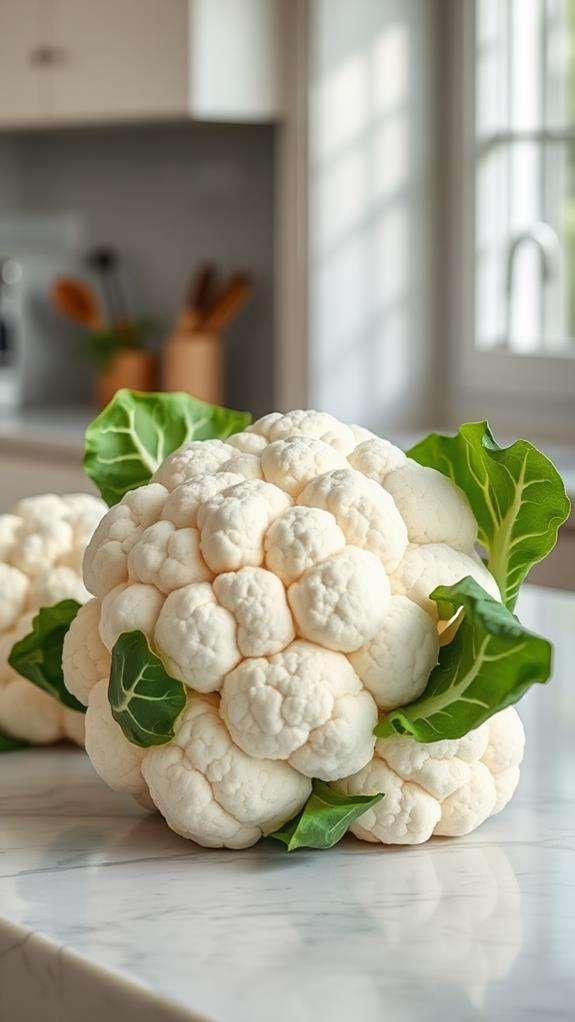
When selecting cauliflower, look for heads that are firm, compact, and creamy white in color. The florets should be tightly packed together without any brown spots, discoloration, or signs of separation. You'll want to check that the attached leaves are fresh and green, as they're excellent indicators of the vegetable's overall freshness.
Turn the head over and examine the stem, which should be clean and free from soft spots. Fresh cauliflower doesn't have a strong smell – if you detect any musty or unpleasant odors, it's best to choose another piece. You'll also want to avoid heads with small black specks between the florets, as these can indicate the beginning stages of decay.
Size isn't necessarily an indicator of quality, but you should guarantee the cauliflower's weight feels appropriate for its size. If you notice any yellow patches developing on the white head, that's a sign the cauliflower is starting to age. The surface should be dry to the touch, but not dehydrated – if it feels slimy or shows signs of moisture between the florets, it's likely past its prime.
Proper Storage Methods

To keep your cauliflower fresh for the longest time possible, you'll want to store it in an airtight container or plastic bag with a few paper towels to absorb excess moisture. The ideal temperature setting for your refrigerator's crisper drawer should be between 40°F and 45°F (4-7°C), which creates the perfect environment for maintaining cauliflower's freshness. When using containers, make sure there's a small amount of space between the cauliflower and the lid to allow for minimal air circulation, but not so much that it promotes rapid deterioration.
Airtight Container Storage Tips
Proper container selection makes a significant difference in extending your cauliflower's shelf life. When choosing an airtight container, opt for one that's slightly larger than your cauliflower head to allow minimal air circulation while preventing moisture buildup. A container with a tight-sealing lid and built-in ventilation holes works best, as it'll regulate humidity levels effectively.
Before placing your cauliflower in the container, wrap it loosely in a paper towel to absorb excess moisture. Don't wash the vegetable before storage, as additional moisture can accelerate spoilage. If you've already washed it, confirm it's completely dry before containerizing. You'll want to inspect the container's seal regularly, as a compromised seal won't maintain the best storage environment.
For pre-cut florets, you'll need a different approach. Store them in a container lined with paper towels, replacing the towels every few days if they become damp. Leave about an inch of headspace at the top of the container, and don't pack the florets too tightly – they need some breathing room to prevent premature browning and maintain their crisp texture.
Best Temperature Settings
The ideal temperature range for cauliflower sits between 32°F and 40°F in your refrigerator's crisper drawer. You'll want to maintain consistent cooling, as temperature fluctuations can lead to condensation and premature spoilage. Most modern refrigerators come with built-in temperature controls, so you should check these settings regularly to verify they're properly calibrated.
Your crisper drawer's humidity setting also plays an essential role in temperature regulation. Set it to high humidity, as cauliflower requires about 95% relative humidity to stay fresh. If your refrigerator's temperature rises above 40°F, you'll notice the florets becoming limp and developing brown spots more quickly. Conversely, if temperatures drop below 32°F, the cauliflower might suffer freezer damage, resulting in soft, water-logged tissue when thawed.
Monitor your refrigerator's temperature using a separate thermometer placed in the crisper drawer, as the built-in thermostat may not always be accurate. If you notice excessive condensation or frost buildup, adjust your temperature slightly higher. Remember that the door compartments are typically warmer than the main cavity, so always store your cauliflower in the crisper drawer.
Typical Refrigerator Shelf Life
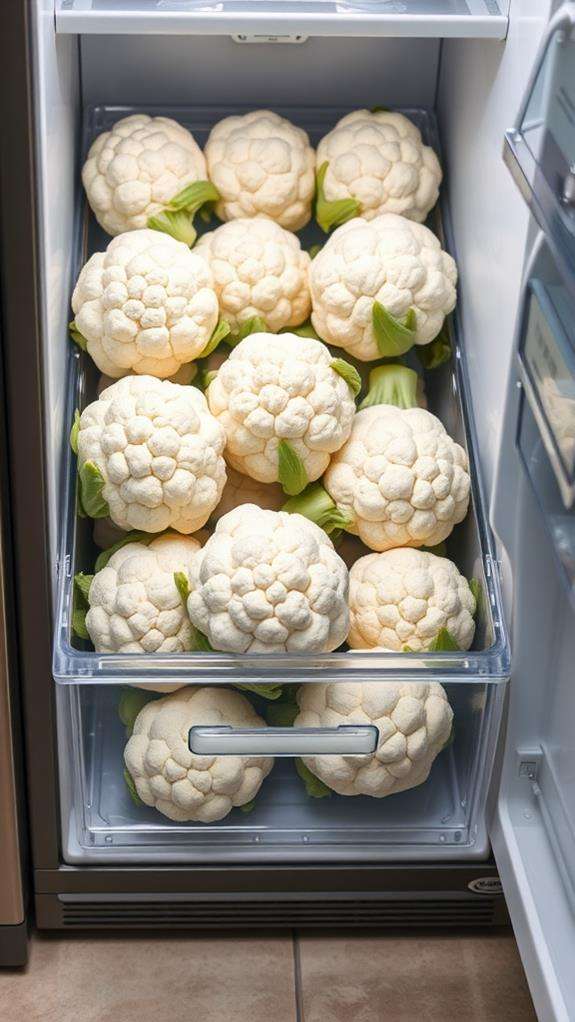
Fresh cauliflower typically lasts 4-7 days in your refrigerator's crisper drawer when stored properly. You'll notice changes in your cauliflower's appearance and texture as time progresses, which serve as key indicators of its remaining shelf life.
| Storage Condition | Shelf Life | Signs of Spoilage |
|---|---|---|
| Whole Head Raw | 4-7 days | Brown spots, soft texture |
| Cut Florets Raw | 3-5 days | Discoloration, mushy feel |
| Cooked | 2-3 days | Off smell, slimy surface |
You can extend your cauliflower's refrigerator life by wrapping it loosely in plastic wrap or placing it in a perforated plastic bag. Don't wash the cauliflower before storing, as excess moisture promotes bacterial growth and accelerates spoilage. If you've already cut your cauliflower into florets, they'll have a shorter shelf life than a whole head, but proper storage can help maintain their freshness. The florets' exposed surfaces make them more susceptible to oxidation and moisture loss, so you'll want to monitor them more closely than whole heads.
Extending Cauliflower Freshness
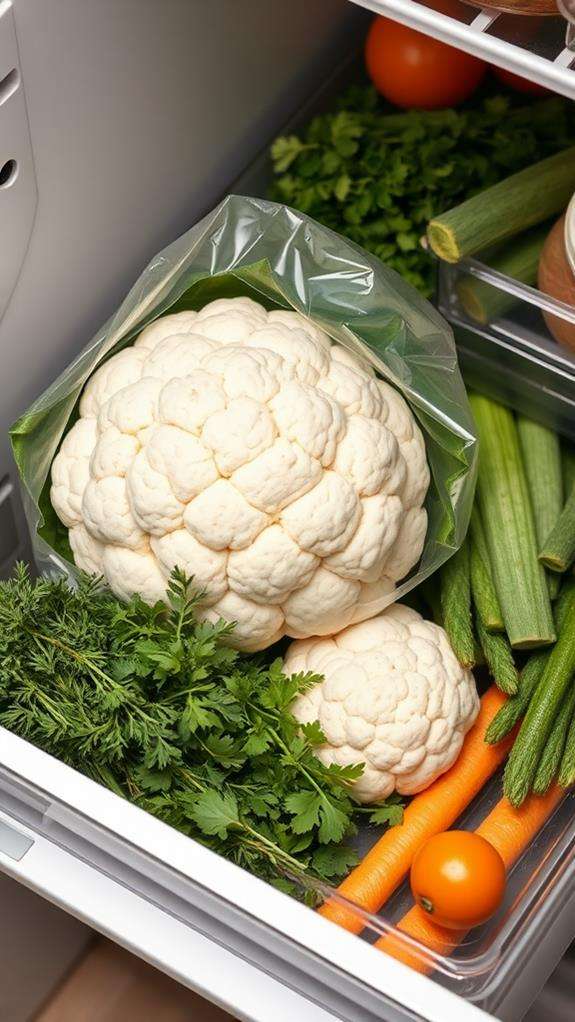
Successfully storing cauliflower for maximum freshness depends on several key preservation techniques. You'll want to keep your cauliflower unwashed until you're ready to use it, as excess moisture can promote bacterial growth and lead to premature spoilage. Instead, wrap the head loosely in a perforated plastic bag that allows for proper air circulation while maintaining adequate humidity levels.
To extend your cauliflower's shelf life, remove any leaves that look wilted or discolored, and trim the stem if it appears brown. You'll maximize freshness by storing it stem-side up to prevent moisture from collecting in the florets. If you've already cut your cauliflower into florets, store them in an airtight container lined with paper towels to absorb excess moisture.
Don't wash or cut your cauliflower until you're ready to use it, as this will greatly reduce its storage life. When you do wash it, use cold water and pat it completely dry before cooking. Remember to check your stored cauliflower every few days for signs of browning or soft spots, removing any affected areas to prevent spread to the remaining portions.
Common Storage Mistakes
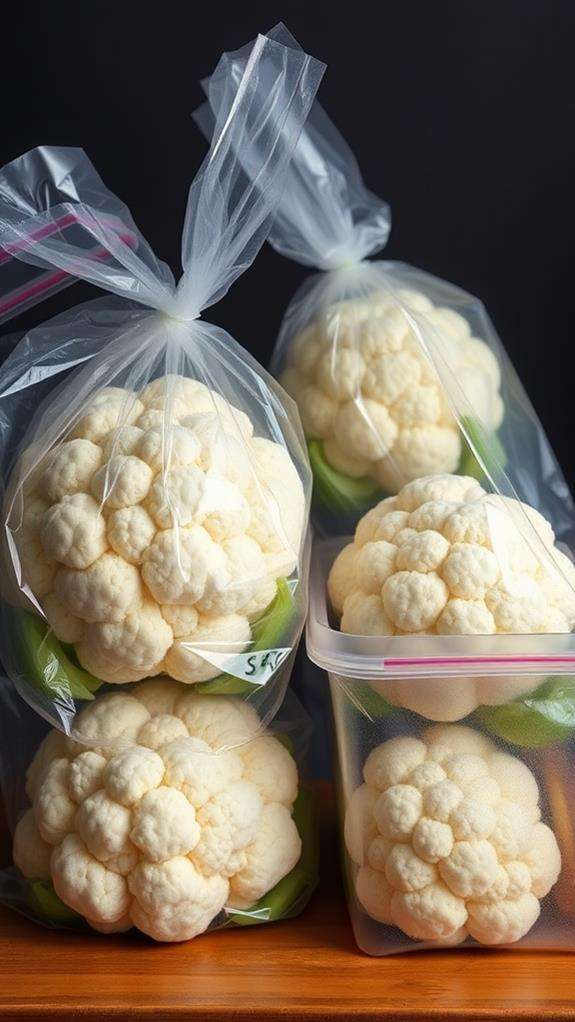
A major mistake you'll want to avoid is storing cauliflower in airtight plastic bags or containers that restrict airflow, as this traps moisture and speeds up deterioration. You're also likely to damage your cauliflower's longevity if you're tossing it into the fridge without a proper storage container, since exposure to other foods and varying humidity levels can lead to premature spoilage. Using perforated bags or containers with small ventilation holes, combined with light wrapping in paper towels, creates the ideal environment for maintaining your cauliflower's freshness.
Storing Without Air Flow
Cauliflower's natural respiration process requires adequate airflow, yet many people make the mistake of storing it in airtight containers or sealed plastic bags. When you trap your cauliflower without proper ventilation, you're creating an environment where moisture accumulates and accelerates spoilage, leading to premature rotting and potential mold growth.
To avoid this common error, you'll want to store your cauliflower in a perforated plastic bag or produce bag that allows for air circulation. If you're using a regular plastic bag, you can create several small holes using a sharp object, spacing them about an inch apart. This modification lets your cauliflower "breathe" while still protecting it from excessive moisture loss. You'll notice that properly ventilated cauliflower maintains its crisp texture and fresh appearance for up to two weeks, compared to just a few days when stored in airtight containers.
Skipping Proper Container Use
Despite their best intentions, many home cooks underestimate the importance of proper container selection when storing cauliflower. You'll find that using the wrong container can considerably reduce your vegetable's shelf life and lead to premature spoilage. When you skip using proper storage containers, you're exposing your cauliflower to excess moisture, ethylene gas, and bacterial growth.
| Container Type | Effectiveness | Common Issues |
|---|---|---|
| Plastic Bags | Poor | Traps moisture, promotes mold |
| Open Container | Very Poor | Leads to dehydration |
| Airtight Glass | Excellent | May crack if dropped |
| Mesh Bag | Good | Limited protection |
| Produce Drawer | Fair | Cross-contamination risk |
You'll want to avoid storing your cauliflower in regular plastic bags or leaving it unwrapped in the produce drawer. Instead, opt for containers that provide adequate ventilation while maintaining proper humidity levels. The best choices are perforated plastic bags or containers with small air holes that allow excess moisture to escape while protecting the vegetable from drying out. Don't forget to check that your container is clean and dry before use, as residual moisture can accelerate spoilage.
When to Toss It
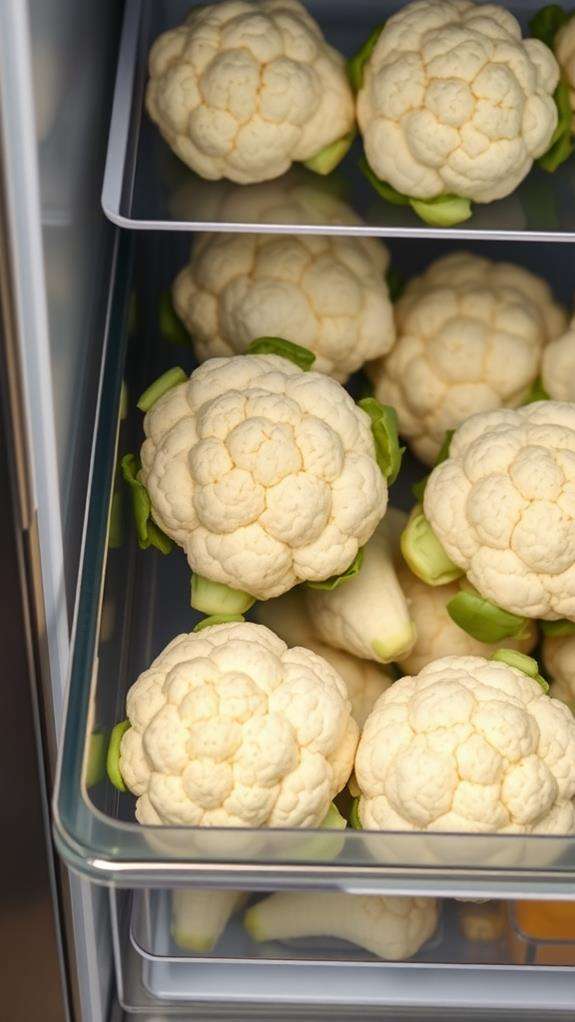
Several clear signs indicate when it's time to throw out your cauliflower. If you notice dark brown or black spots spreading across the florets, that's a clear indication of decay setting in. When your cauliflower develops a strong, unpleasant odor that's distinctly different from its usual mild scent, you'll want to discard it immediately.
Watch for texture changes, as they're reliable indicators of spoilage. If your cauliflower feels slimy to the touch or has become soft and mushy, don't risk consuming it. You'll also want to check for any signs of mold growth, which typically appears as fuzzy spots in various colors, including white, green, or black. When the creamy white color of fresh cauliflower turns to yellow or brown, especially if it's accompanied by wilting, it's past its prime.
Don't ignore small brown specks on the surface, as they often signal the beginning of deterioration. If your cauliflower has been in the fridge for more than two weeks, even without visible signs of spoilage, it's best to err on the side of caution and dispose of it.
Best Storage Containers

The right storage container can greatly extend your cauliflower's freshness. When selecting storage options, you'll want to focus on containers that provide adequate airflow while maintaining the right humidity level. Airtight plastic containers with ventilation holes or produce-specific storage containers work exceptionally well for keeping your cauliflower crisp and fresh.
- Mesh produce bags – They allow proper air circulation, preventing moisture buildup that can lead to premature spoilage
- Perforated plastic containers – These maintain ideal humidity while letting excess moisture escape
- Glass containers with vented lids – They're excellent for visibility and monitoring freshness while providing controlled airflow
- Specialty produce keepers – These often include built-in humidity controls and proper ventilation systems
Your container should be large enough to accommodate the cauliflower head without crushing the florets. If you've cut your cauliflower into smaller pieces, you'll want to use a container with compartments or adjustable dividers. Don't forget to line your container with paper towels to absorb excess moisture, and avoid using completely sealed containers that can trap ethylene gas and accelerate spoilage.
Temperature and Humidity Control
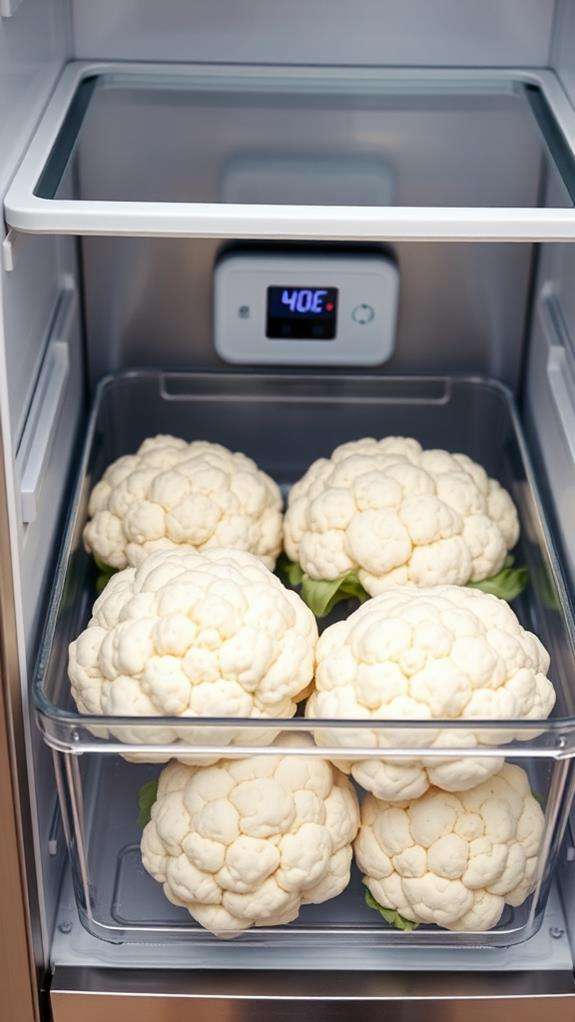
Maintaining ideal temperature and humidity levels stands essential for maximizing your cauliflower's shelf life. You'll want to keep your refrigerator's temperature between 32°F and 40°F (0-4°C), with the ideal sweet spot being 36°F (2°C). The crisper drawer, where you'll store your cauliflower, should maintain a relative humidity level between 85-95%.
If your refrigerator has adjustable humidity controls on the crisper drawers, you'll want to set them to "high" for your cauliflower. The vegetable needs moisture to stay fresh, but you don't want excess condensation that could promote bacterial growth. If you notice water droplets forming inside your storage container, you can adjust the humidity slightly lower or add a paper towel to absorb extra moisture.
You can monitor your fridge's temperature using an inexpensive refrigerator thermometer, which you'll find particularly helpful if you've got an older model without a built-in temperature display. Remember, temperature fluctuations can occur when you frequently open and close your refrigerator door, so try to minimize these disruptions to maintain consistent conditions for your cauliflower.
Frequently Asked Questions
Can You Safely Refreeze Thawed Cauliflower?
You shouldn't refreeze thawed cauliflower unless you've cooked it first. When raw cauliflower thaws, it develops ice crystals that damage cell walls, leading to texture changes and potential bacterial growth. However, if you've cooked the thawed cauliflower, you can safely refreeze it, though you'll notice some quality loss. For best results, you'll want to use thawed cauliflower immediately or cook it before considering refreezing.
Does Cutting Cauliflower Into Florets Affect Its Nutritional Value?
Cutting cauliflower into florets won't greatly impact its nutritional value, as long as you're mindful of your preparation method. You'll retain most vitamins and minerals when you cut and store the florets properly. However, you'll want to minimize the time between cutting and cooking, as exposure to air can lead to minor nutrient loss. If you need to pre-cut, store your florets in an airtight container to preserve their nutritional benefits.
Is It Safe to Eat Cauliflower That Has Turned Slightly Pink?
You shouldn't eat cauliflower that's turning pink, as this discoloration typically indicates bacterial growth or oxidation. While slight browning can be normal, pink spots are a warning sign that your cauliflower's going bad. This color change often appears alongside other spoilage indicators like soft spots or unpleasant odors. For your safety, it's best to discard pink-tinged cauliflower and get a fresh head instead.
Can Cauliflower Be Stored Next to Fruits in the Refrigerator?
While fruits bring vibrant colors to your fridge, you shouldn't store cauliflower next to them. Here's why: fruits release ethylene gas, a natural ripening hormone that can cause your cauliflower to spoil faster and develop brown spots. You'll want to keep your cauliflower in the crisper drawer, separate from ethylene-producing fruits like apples, bananas, and pears. This separation will help maintain your cauliflower's freshness and extend its shelf life.
Does Washing Cauliflower Before Storage Make It Spoil Faster?
Yes, washing cauliflower before storage can make it spoil faster because excess moisture promotes bacterial growth and mold development. You'll want to keep your cauliflower dry until you're ready to use it. If you've already washed it, make sure to dry it thoroughly with paper towels or a clean kitchen cloth, and store it in a perforated plastic bag that allows for some airflow while preventing excess moisture buildup.





